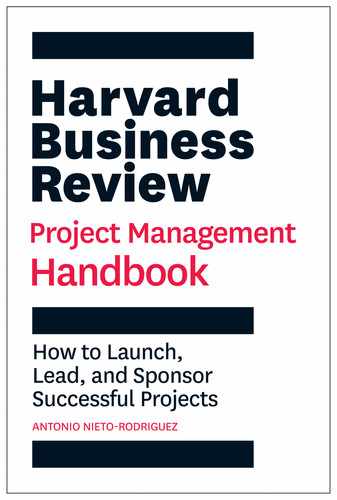The one primer you need to launch, lead, and sponsor successful projects. We're now living in the project economy. The number of projects initiated in all sectors has skyrocketed, and project management skills have become essential for every leader and manager. Still, project failure rates remain extremely high. Why? Leaders oversee too many projects and have too little visibility into them. Project managers struggle to translate their hands-on, technical knowledge up to senior management. The result? Worthy projects are starved of time and resources and fail to deliver benefits, while too much investment goes into the wrong projects. To compete in the project economy, you need to close this gap. The HBR Project Management Handbook shows you how. In this comprehensive guide, project management expert Antonio Nieto-Rodriguez presents a new and simple framework that will increase any project's likelihood of success. Packed with case studies from many industries worldwide, it will teach you how to manage your organization's projects, strategic programs, and agile initiatives more effectively and push the best ones ahead to completion. Timeless yet forward-looking, this book will help you win in the project-driven world. In the HBR Project Management Handbook you'll find: You'll learn: HBR Handbooks provide ambitious professionals with the frameworks, advice, and tools they need to excel in their careers. With step-by-step guidance, time-honed best practices, and real-life stories, each comprehensive volume helps you to stand out from the pack—whatever your role.
Table of Contents
- Cover
- Title Page
- Copyright
- Contents
- Introduction: Welcome to the Project Economy
- PART ONE: Project Fundamentals for Everybody
- 1. Projects Everywhere
- Operations run the organization, but projects change the organization
- The proliferation of projects in organizations
- Projects after the pandemic
- 2. What Is a Project?
- Definitions
- Classification of projects
- Examples of common projects
- 3. What Project Management Is Now
- The reinvention of project management
- Pushing the reinvention further
- PART TWO: The Project Canvas
- 4. Introduction to the Project Canvas
- Simple, universal, and proven
- Outline of the canvas parts
- 5. The Foundation
- Purpose: Why are we doing the project?
- Investment: How much will the project cost?
- Benefits: What benefits and value will the project generate?
- 6. The People
- Sponsorship: Who will be accountable for the project?
- Resources: Who will manage the project, and which skills are needed to deliver the project?
- Stakeholders: Who will benefit from and be affected by the project?
- 7. The Creation
- Deliverables: What will the project produce, build, or deliver?
- Plan: How and when will the work be carried out?
- Change: How will we engage stakeholders and manage the risks?
- 8. Putting the Project Canvas into Practice
- How to use the Project Canvas
- Writing the Project Canvas block by block
- Case studies of the Project Canvas in action
- Applying the Project Canvas to agile initiatives
- Tips for introducing the Project Canvas in your organization
- Example of an organization implementing the Project Canvas
- PART THREE: Individual and Organizational Project Competencies
- 9. Project Leadership
- The growing need for effective project leaders
- Project leadership qualities and competencies
- 10. Selecting and Prioritizing Projects
- Why prioritization helps
- Benefits of managing a portfolio
- The hierarchy of purpose: A better way to prioritize
- 11. The Agile and Project-Driven Organization
- How some Chinese companies embody organizational agility
- Benefits of a lean, agile, and project-driven structure
- Obstacles to becoming an agile and project-driven organization
- PART FOUR: A Better Future through Projects
- Appendix: The Benefits Card
- Notes
- Index
- Acknowledgments
- About the Author
